OneBlade Razor Review
I think it’s safe to say that most men love a well-designed product.
Whether you are using some flagship tech device or a razor, when a product looks and feels great in your hand, there is something magical about that feeling.
But here’s the deal:
While the design is important – performance is everything.
Just because a product looks good doesn’t mean a thing if it’s unable to complete the task that it was designed to do.
Today, I want to give you a detailed look at the OneBlade razor – perhaps the most beautiful razor that is currently on the market.
Beyond just a detailed unboxing, I will also share with you the experience of how this razor performs and if it truly is as revolutionary as it claims to be.
Let’s begin:
About The OneBlade Company
OneBlade was founded by Tod Barrett in 2014 and is based out of Austin, TX (source).
The most striking part of this company that caught our eye is the research and development that went into creating the OneBlade razor that we will be reviewing.
You can read more about OneBlade here.
Unlike virtually every other men’s razor, the OneBlade Core was made in the USA (San Diego, California).
Unboxing OneBlade
Before we get into the shaving experience, I first want to take you through the unboxing experience of the OneBlade Core.
Editor’s Note: We paid for this unit through Amazon as shipping was cheaper and faster. Therefore, should you decide to order direct, the experience may be slightly different from the pictures below.
Here’s the box that the OneBlade Core comes in:
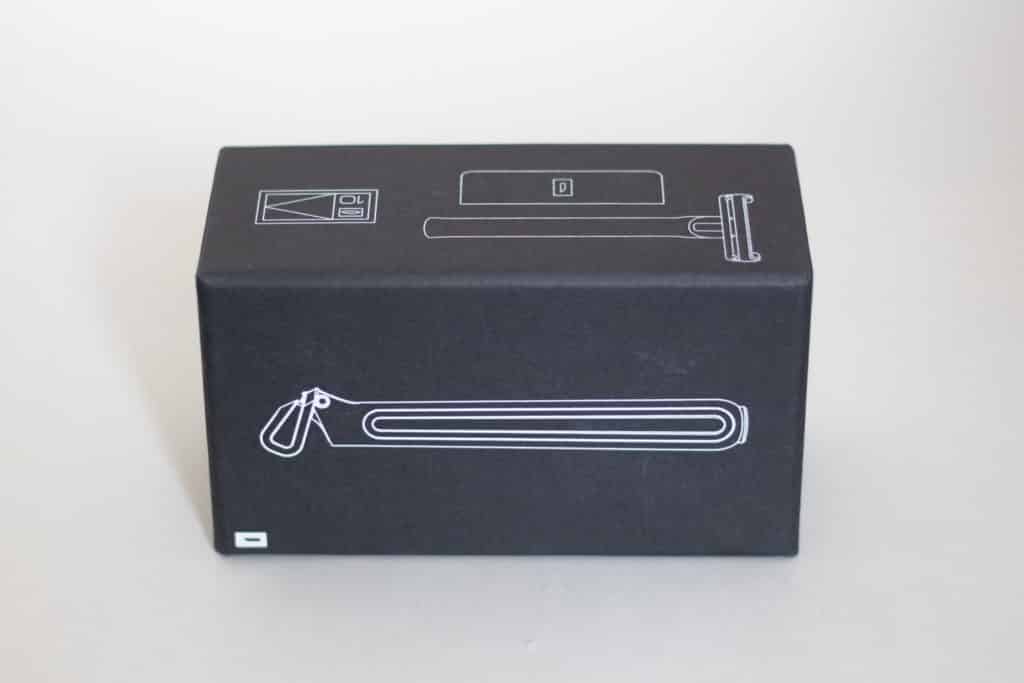
As you may have guessed by looking at the razor itself, the packaging is fairly minimalist.
As a quick side note, given that the OneBlade Core comes in a nice box, if you are planning on giving this razor as a gift, then you won’t need any other supplies other than just wrapping paper.
Now once you open up the box, you will find the following contained within:
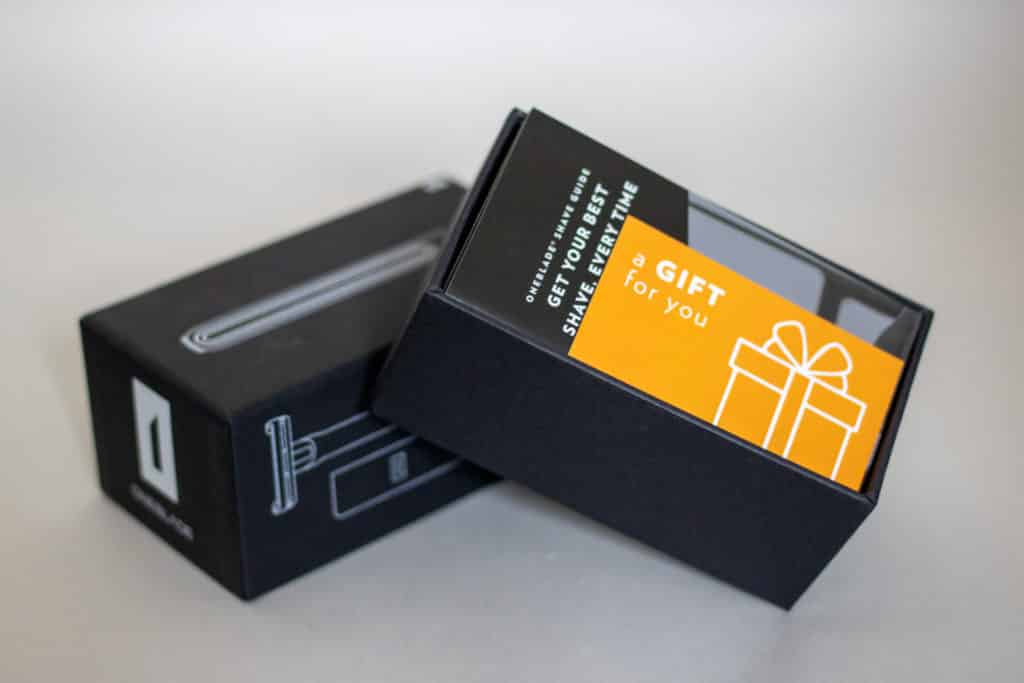
You will find the following:
- Shave Guide: Provides you with step-by-step instructions on how to use the OneBlade Core. You can view this in greater detail in these high-resolution pics: Front, Back.
- Instructional Guide: Tells you to visit this page before shaving (you will want to do this).
- A promotional offering to provide feedback on your experience.
Now for the big reveal, the razor itself:
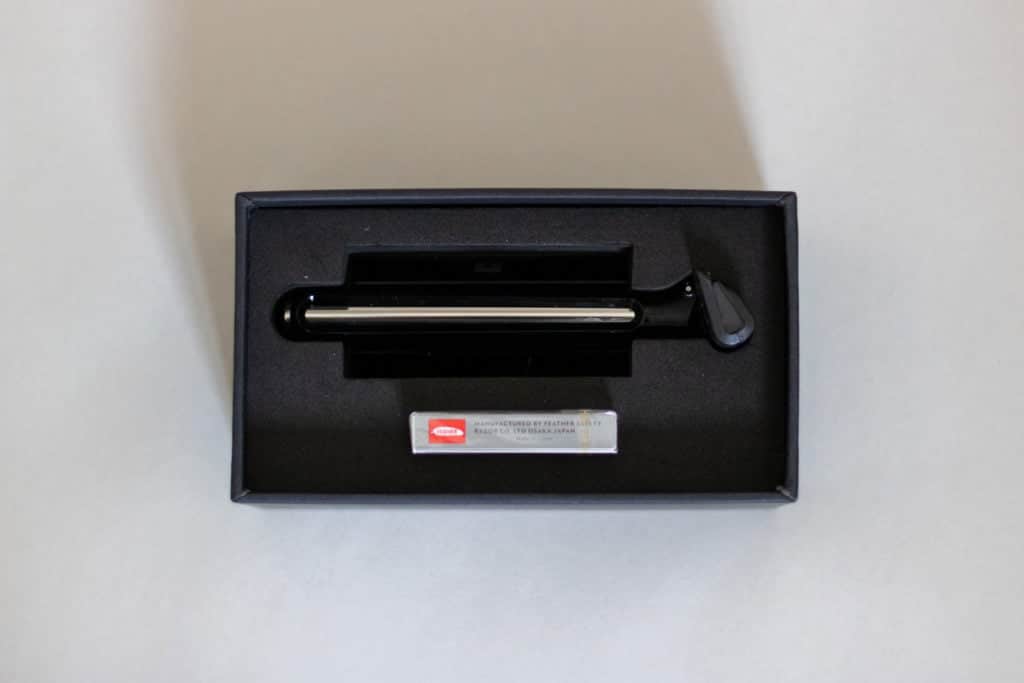
Here we can see the following:
- OneBlade Core razor
- Feather FHS-10 single edge razor blades
- Razor stand (underneath the razor – it’s matte black)
Here’s a closer look at the razor from a few different angles to give you a better idea of the details:
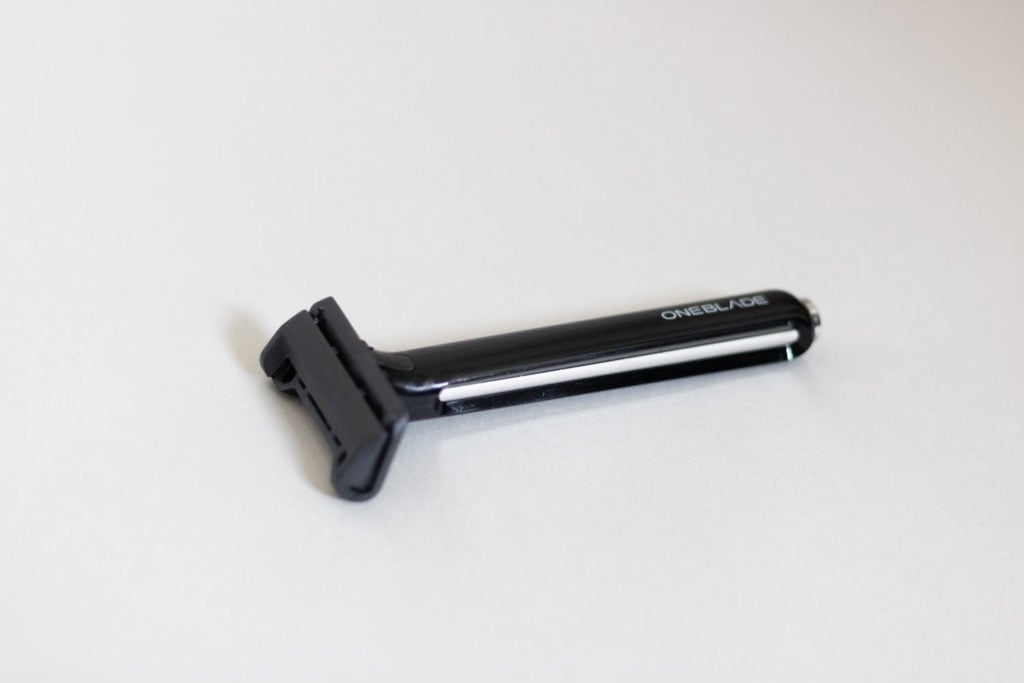
Given that this is their most affordable model (more on this later), the head and body exterior is made from lower-grade materials.
However, it is worth noting that the silver you see in the middle of the razor’s body is a solid rust-resistant stainless steel which provides some weight to the razor.
And here is a quick look at the highly-touted Feather razor blades (these are not the same razor blades used in safety razors as you will learn in a minute) :
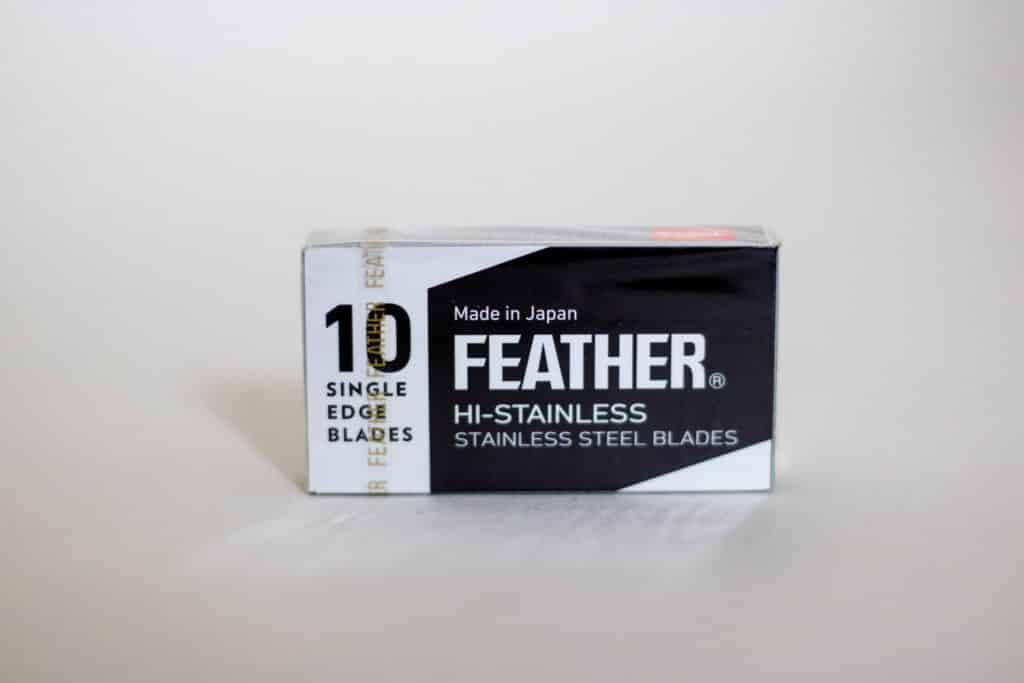
Along with the OneBlade Core stand:
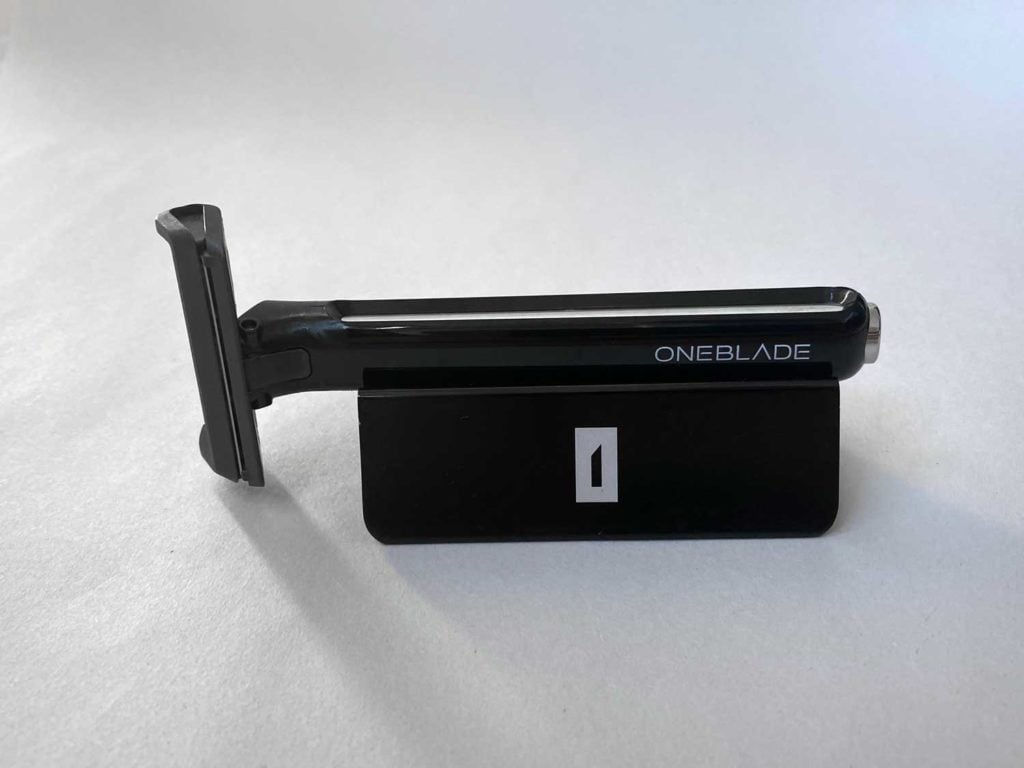
The stand itself is made from anodized aluminum which is lightweight, durable, and corrosion-resistant (source).
We wanted to compare how the OneBlade Core stacks up to other popular razor systems on the market which includes the Gillette Fusion ProGlide, Schick Hydro 5, and Merkur 38 (Barberpole) in terms of weight.
Here’s what we learned:

As you can see from the image above, the results are as follows:
| Razor | Weight |
| Merkur 38 | 3.88oz / 110g |
| OneBlade Core | 2.33oz / 66g |
| Gillette Fusion ProGlide | 1.69oz / 48g |
| Schick Hydro 5 | 1.45oz / 41g |
While not nearly as heavy as the Merkur safety razor, the OneBlade Core will feel a little bit heavier if you are coming from a cartridge razor.
When it comes to head width, the OneBlade Core is slightly wider due to the razor blade holder.
However, the razor blade itself is about the same width as other blades.
Lastly, the length of the OneBlade Core.
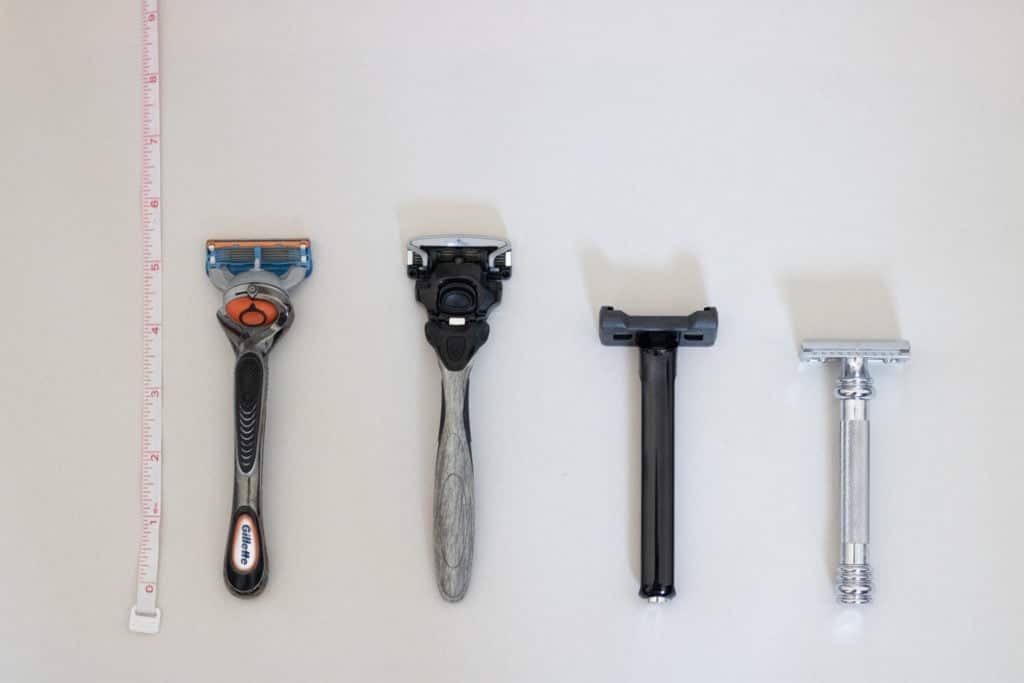
Just like the weight, the OneBlade is not nearly as short as a traditional safety razor, but it is a fair bit shorter when compared to other cartridge razors. The total length is just a hair under 4.5″ (~11.5cm).
Lastly, and perhaps the most important feature of the OneBlade Core is the pivot head.
Unlike safety razors that feature a fixed head, the OneBlade Core smartly borrows the pivot head that is found in most cartridge and disposable razors:
As you can see in the image above, the OneBlade Core can pivot just as far as the leading cartridge razors.
Why is this feature important?
If you’re coming from a cartridge razor background, this pivot head will make for a very familiar shave experience.
Unlike when using a traditional safety razor, you don’t have to worry about the shaving angle nearly as much.
This results in a lower learning curve when compared to a safety razor.
Shaving With OneBlade
Now to the fun part – trying out the OneBlade Core!
To split up this section, I will share with you the following:
- My pre-shave prep routine
- How the razor performed on each of the three passes
Let’s begin:
Pre Shave Prep
The steps that you take before shaving are nearly as important as the shave itself.
Before the razor blade even touched my face, I made sure to heed OneBlade’s advice and took a shower under warm water and did a gentle pre exfoliation to soften my whiskers (this advice should be used before shaving with any razor – not just OneBlade).
Once my beard was dried with a towel, I went ahead and took a quick mental note of how my facial hair grows in.
As recommended by OneBlade, you will want to make sure that you make the following passes:
- With the grain
- With the grain
- Against the grain
The first two will help cut the hair down to skin level while the third pass will help to provide a silky smooth finish.
Now that I got an idea of how my facial hair grows in, I went ahead and injected a single Feather blade into the OneBlade until I heard an audible click thanks to the unique load blade system.
Once the razor had been loaded, I then gave it a quick rinse under the water to clean the blade and free it of any adhesives:
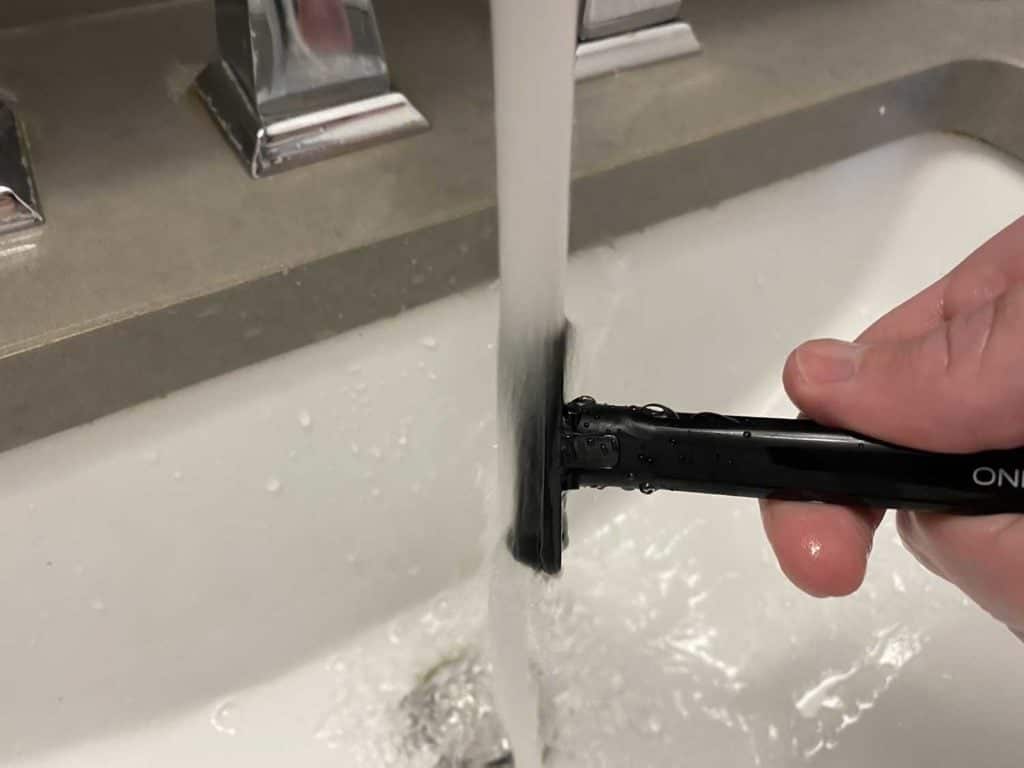
And then I went ahead and applied a liberal amount of latherless shave cream (Cremo reviewed here) to my entire face.
First Pass
Now that everything is prepped and ready to go, I went ahead and took my first stroke with the razor:
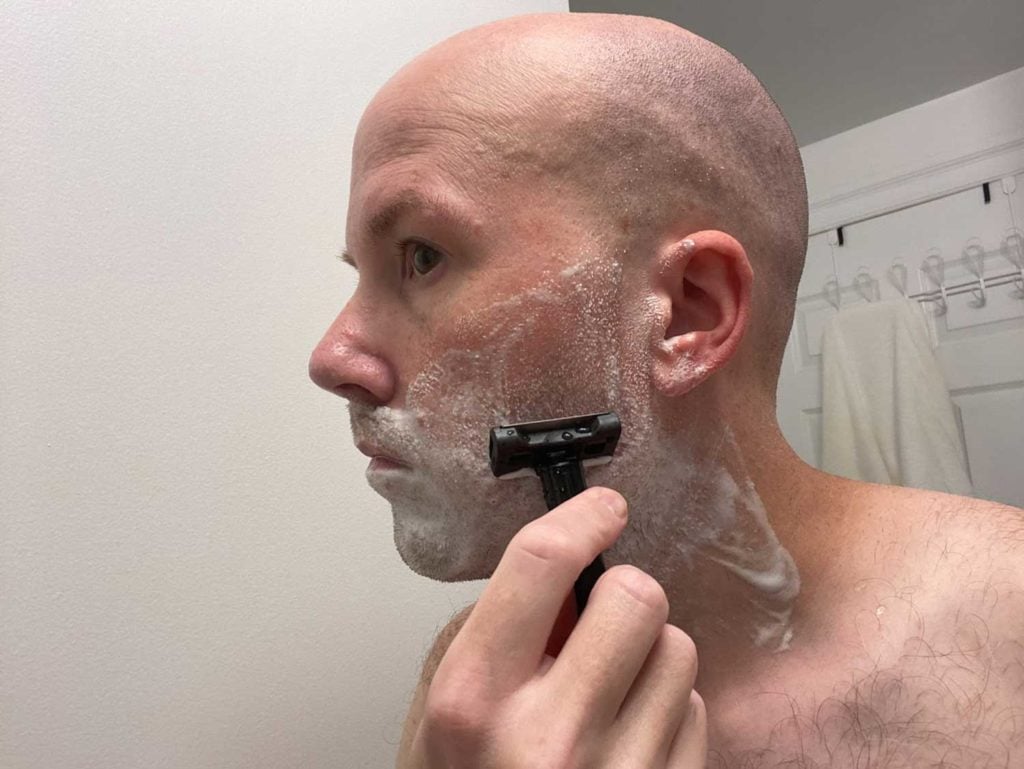
Effortless.
The super sharp (and thin) Feather blades made quick work of my facial hair.
For those following along at home, my facial hair is fairly dense and around medium when it comes to coarseness.
As I worked my way down the cheek, the OneBlade made quick work of my whiskers.
As you can see from this straight angle, the OneBlade did leave some texture visible after the first initial pass:
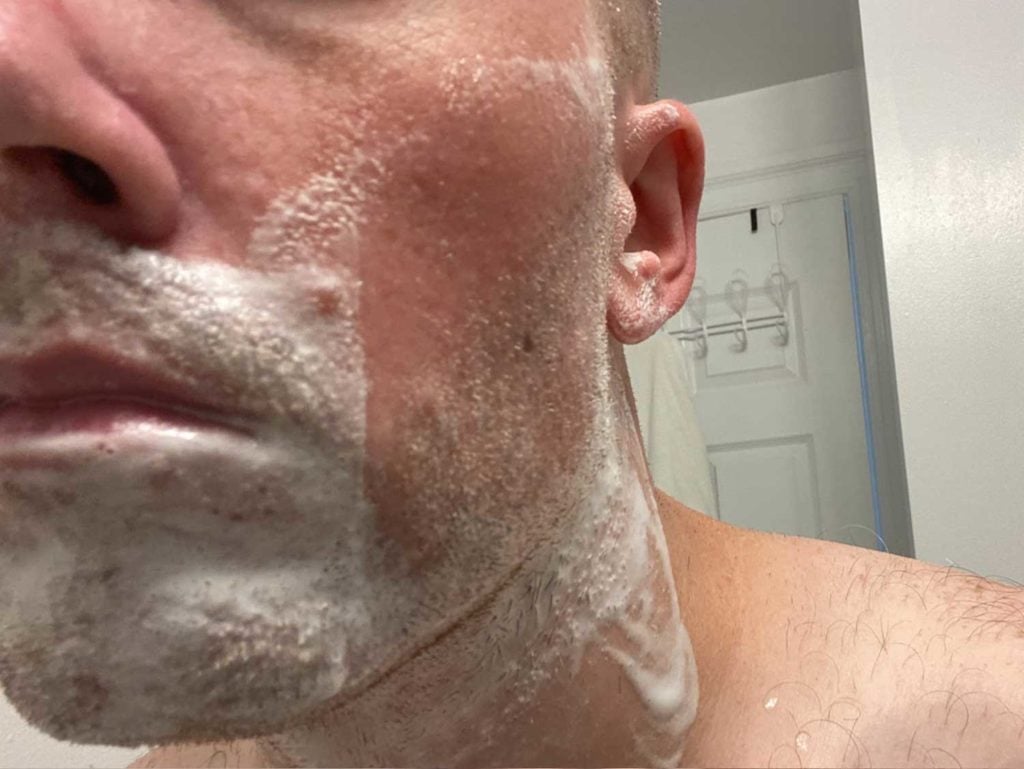
This is about in line with what you would expect from a standard safety razor.
As I worked my way around the chin area, I was impressed with the pivot head.
The OneBlade had no problem cutting most of the whiskers along the sharp contour of my jawline.
To give you a clear view of the final results after one pass, here is how things looked on both my cheek and neck area.
Editor’s Note: Areas that were missed (such as the long hairs on my lower neck) are purely my fault and not a result of the performance of the blade itself. Trying to take pictures while shaving is quite distracting!
Overall, the performance of the OneBlade on the initial pass was pretty impressive. I enjoyed the pivot head as it allowed me to focus more on my shave rather than the angle of which I was holding the razor.
Furthermore, areas where I have had common problems with in the past around my face, the OneBlade performed very well.
There was very little razor burn or skin irritation thanks to the single blade razor.
Second Pass
To try and clean things up a bit more, here is how the OneBlade performed on the second pass:
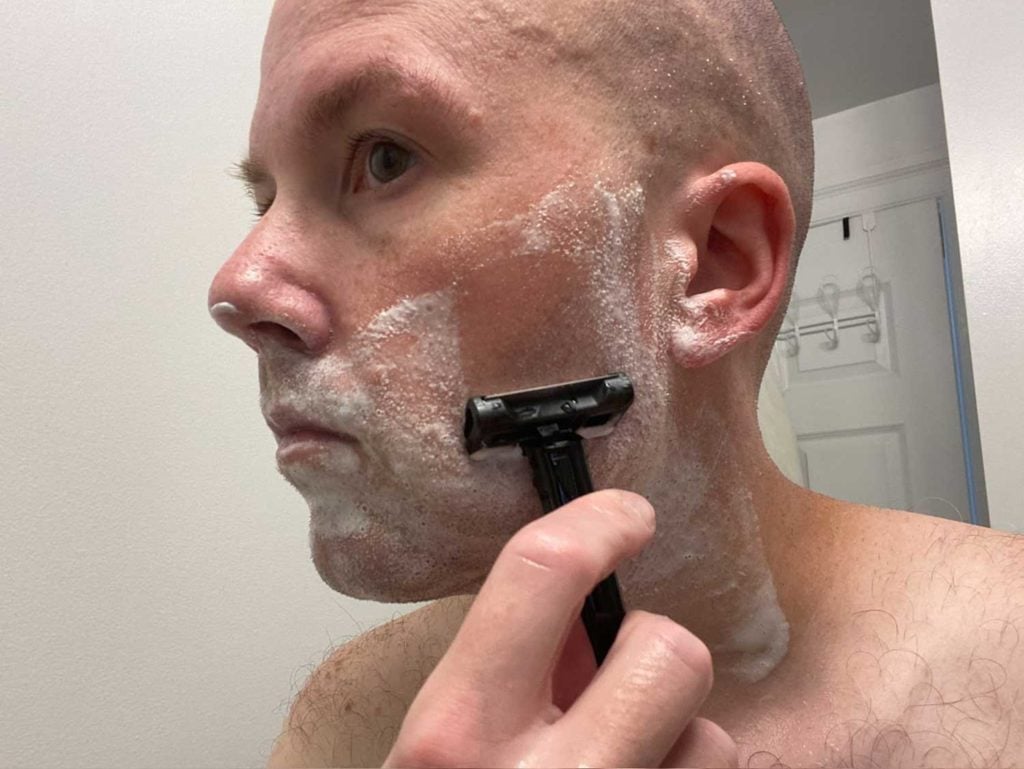
On both cheeks, the razor helped to cut down the hair to achieve much smoother results.
And when going with the grain on the neck, the OneBlade did pretty well for these naturally curly hairs:
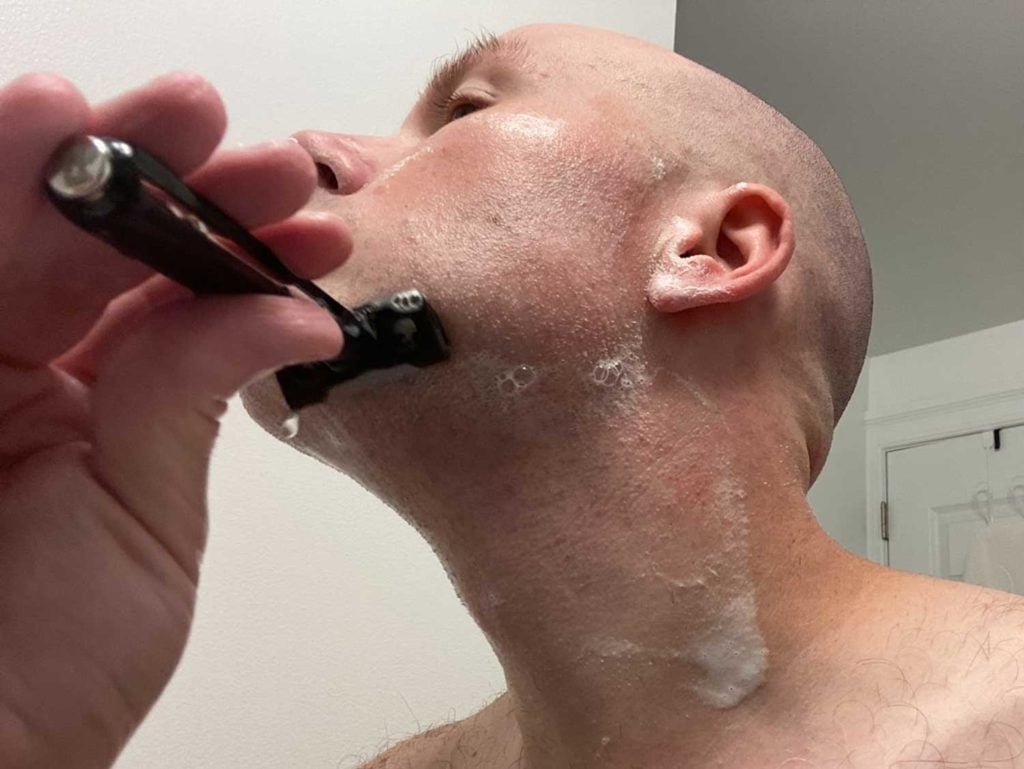
Overall, the OneBlade provided consistent results between both the first and second passes. If anything, this speaks to the consistency you should expect from this razor shave after shave.
Third Pass
Now for the third and final pass – against the grain.
Here’s where things can get to be dicey for a lot of men. That’s because it takes a bit of practice to shave this way as it is the exact opposite of what you were doing previously.
So for the upper cheek area, I went ahead and took short overlapping strokes.
The razor did a fairly good job of really smoothing things out without feeling too aggressive on my skin.
Post-Shave Pics
Lastly, the final results. After letting my face fully dry out, here is how things looked about 10 minutes after shaving:
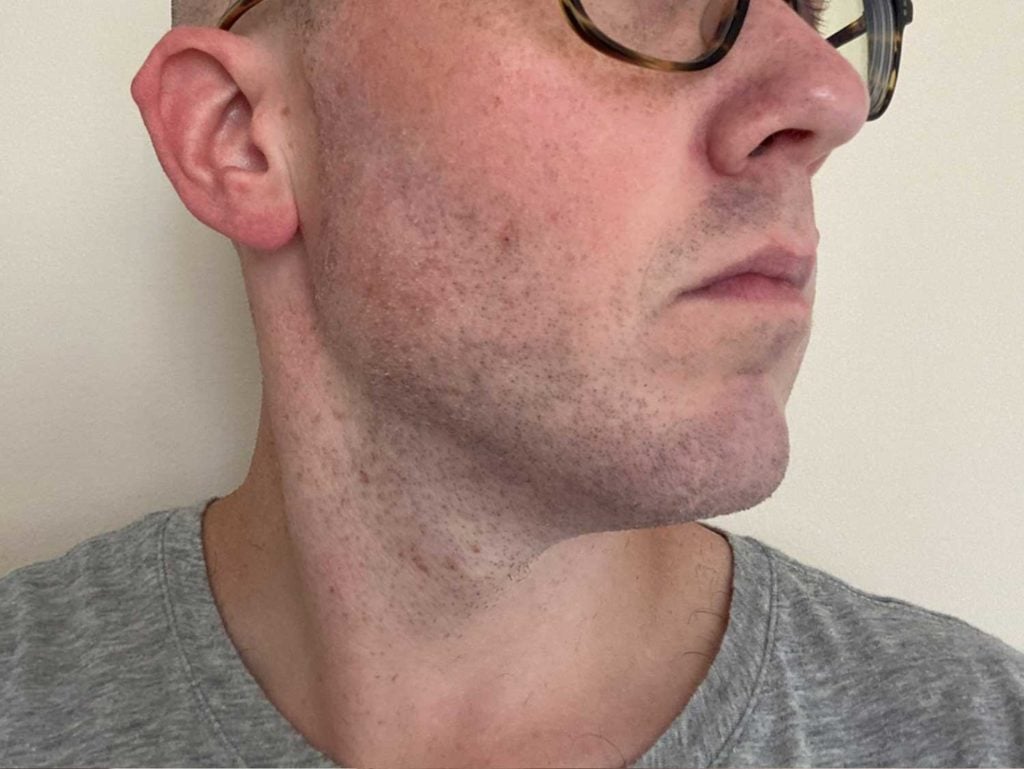
Overall, I am pretty happy with the results.
While there is some noticeable texture to my facial hair as it does grow a bit darker, the OneBlade was able to cut the hair down significantly to feel pretty damn smooth.
Limitations of the OneBlade Razor
The tricky thing about the OneBlade is that it is neither a cartridge razor nor is it a safety razor; it truly is a hybrid of both.
While this is a good thing when it comes to costs (more on this in a minute), it does inevitably have some limitations on what it can and cannot do.
The biggest limitation that will be a problem for most men will be either one of the following:
- Manscaping
- Travel
Manscaping
Whether you are cleaning up the hair around your groin region or shaving your head, I would suspect that using the OneBlade can be a bit challenging.
Now I will be the first to admit that I didn’t use the razor for either – so take that into consideration.
Based on my experience of seeing and feeling how the OneBlade performed when cutting facial hair, I simply don’t have quite enough confidence in the razor quite yet.
Even when searching around the OneBladeShave.com website, I couldn’t find much for men reporting their manscaping results.
The takeaway here:
I don’t think buying the OneBlade Core primarily for manscaping is a smart move; it doesn’t in any way seem designed for such use.
Travel
In a post 9/11 world, the items that you can carry onto a plan have been drastically limited.
One of the affected categories were razor blades.
The razor blades used by the OneBlade Core are not allowed onto flights per the TSA.
Therefore, if you plan to travel via air with the OneBlade, then you will need to check your luggage. This can be a major inconvenience especially given that the type of razors blades used in the OneBlade cannot be easily purchased from a local drug store upon arrival…
…which brings us to our next point:
Compatible Razor Blades
The type of razor blades used in the OneBlade isn’t the same type that is used in double edge safety razor blades (I mistakenly made this assumption before).
Instead, the OneBlade was designed to work only with the Feather FHS single edge blades.
Here’s how the Feather FHS single blade differs from their double edge blade:
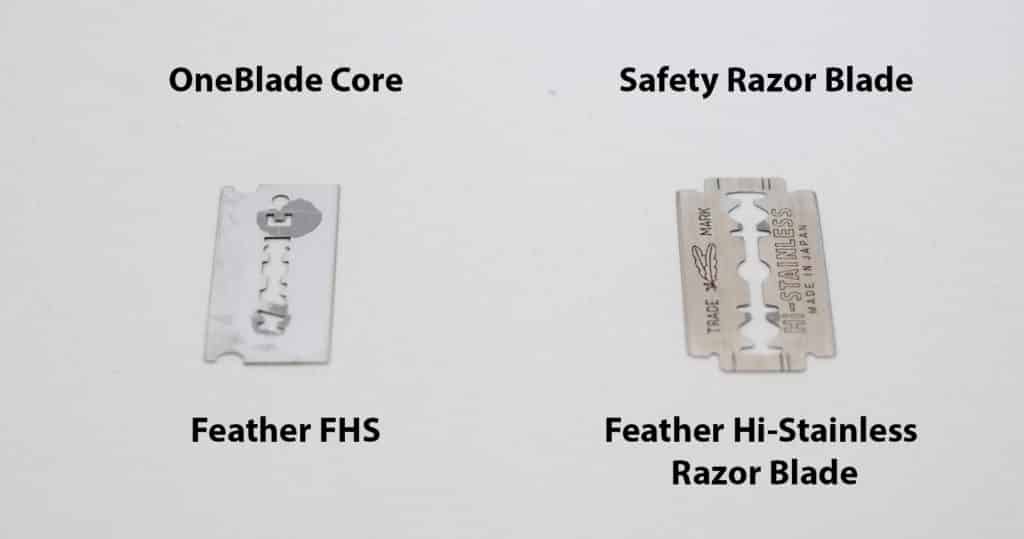
As you can see, while similar, the safety razor blade is much wider and features a cutting edge on both sides of the blade whereas the Feather FHS just has a single blade and a PVD coating (learn more).
This difference may be a problem for some.
It’s not necessarily that Feather is a bad blade by any measures (in fact most men find that they are among the best), but rather that you are locked into a particular blade system – which is very ‘cartridge razor-like’.
Therefore, if you find that the razor blades just don’t do a good job for your facial hair type, your options of razor blades are limited.
Furthermore, there are some limitations on both availability and affordability.
When it comes to availability, you aren’t going to find the FHS blades at a corner store – so if you are in a pinch, this could be a problem.
Instead, you are going to have to go through either a large online retailer such as Amazon or eBay, direct from OneBlade, or through a specialty shave shop such as Maggard’s.
Lastly, the price.
While still significantly cheaper than a traditional cartridge razor, each FHS-10 replacement blade will typically last you about 2 to 4 shaves before it needs to be replaced.
This equates to roughly $0.25 per shave – which is about double the cost when compared to the Feather double edge safety razor blades.
Regardless, the savings will be welcomed if you are coming from a cartridge razor system.
Where to Buy the OneBlade Razor
At the time of publication, the OneBlade can be found at some of the following retailers:
- Amazon
- Maggard’s Razors
- Direct from OneBladeShave.com
- eBay
Return Policy & Warranty of OneBlade
While we strongly recommend for you to read their policies for the most accurate and up-to-date information, there were a few key points we wanted to share about their policies:
Return Policy
You have 60 days to return your razor in order to get a refund.
You are responsible for covering the shipping costs.
If you purchased a razor with a custom engraving or a refurbished model, those sales are final and cannot be returned.
Click here for the most up-to-date information about their return policy.
Warranty
OneBlade provides a lifetime guarantee for their razor.
Whether you decide to purchase the OneBlade Core or the flagship OneBlade Genesis, you can have some peace of mind should the razor ever break from a sudden fall.
Alternatives to the OneBlade Razor
While the OneBlade is quite remarkable as a shaving system, they are not without some competitors.
If you like to evaluate all of the options before you make your purchase, here are a few other brands you may want to check out:
- Supply: The closest competitor to OneBlade will be Supply. Relying on “non-proprietary injector style blades”, the single edge Supply razor features a cartridge-like body that is both slick and minimal. The standard Supply razor is a bit pricier when compared to the OneBlade Core and costs $75.
- Leaf: The award for the razor with most “bling” will be Leaf. Featuring a detailed cartridge-like body, this shaving system relies on 3 double edge safety razor blades (snapped in half) and provides an experience similar to a traditional cartridge razor. The Essentials starter kit starts at $79.
- Safety Razors: From Merkur to Parker, safety razors are an affordable and effective way to shave daily. While some learning is required, these razors can provide a close and clean shave. Just expect to have some cuts along the way.
Other OneBlade Razors
While the focus on this guide was just the OneBlade Core, we would be kicking ourselves if we didn’t at least touch on OneBlade’s other offerings. Here a quick overview of their lineup:
- OneBlade Core: in what we reviewed today, the Core features a plastic head and polymer body (with a steel insert). The head pivots and provides a great and close shave at an affordable price. The price of the Core starts at $19.99.
- OneBlade Hybrid: The Hybrid is a step up from the Core that appears to feature the same handle as the Core. However, the head on the Hybrid is made from military-grade stainless steel. The price of the Hybrid starts at $99.
- OneBlade Genesis: The flagship razor that started it all, the Genesis features a no-holds-barred design and relies on the best materials out there. The stainless steel design has been hand polished and individually numbered. Custom engraving and luxury finishes set this apart from virtually every other razor on the market. The price of the Genesis starts at $299.
Philips Norelco OneBlade vs. OneBlade Razor
Only in the shaving vertical could you have separate shave systems come out and have nearly identical names while being so drastically different.
If you heard about the OneBlade before but are completely confused about the name and the features, then you may want to take a look at the other OneBlade…Philips OneBlade.
Introduced only a few short years ago, the Philips OneBlade is a hybrid electric razor that is designed for both face and body use. It’s a unique system that in no way shape or form is like the OneBlade we reviewed today.
If you want to learn more about the Philips OneBlade, then you should check out our detailed review here.
Final Thoughts on OneBlade Razor
It’s easy to see why there is so much hype around this entry level OneBlade razor. Perfectly bridging the divide between a cartridge razor and a safety razor thanks to the build quality, moderate price point, and affordable replacement blades – the OneBlade is a great evolutionary step for shaving as a whole.
If you tried traditional wet shaving in the past yet were turned off by the proper shave technique and angle and are looking for an easier alternative, then you should consider picking up this razor.
While it does have some shortcomings when it comes to utility and travel, we would recommend it to anyone looking for a great shave.
It not only provides a reliably close shave, but it will also make back its investment thanks to the cheaper razor refills (when compared to a cartridge razor).